The two men began as neighbors. And they ended as neighbors.
In between were tens of thousands of head of cattle, millions of gallons of oil, hundreds of thousands of acres of land, hundreds of millions of dollars of wealth.
And a half-century of friendship.

Samuel Burk Burnett (left) was born in Missouri in 1849, William Thomas Waggoner (right) in Hopkins County in 1852.

 By 1860 Burnett’s family was raising cattle in southern Denton County; Waggoner’s family was raising cattle on the prairie near Decatur in Wise County. Burnett’s family moved to Wise County, and the two boys became friends about 1865 when they met as classmates at a country school at Prairie Point (present-day Rhome). Those two boys would skew considerably the future per-capita income of that school’s graduates.
By 1860 Burnett’s family was raising cattle in southern Denton County; Waggoner’s family was raising cattle on the prairie near Decatur in Wise County. Burnett’s family moved to Wise County, and the two boys became friends about 1865 when they met as classmates at a country school at Prairie Point (present-day Rhome). Those two boys would skew considerably the future per-capita income of that school’s graduates.
Each man began his career in cattle. In 1870 Burnett married Ruth Loyd, daughter of another cattleman, Martin Bottom Loyd. (Loyd’s great-granddaughter was Anne Burnett Tandy, wife of Charles.) In 1871 Burnett, then just twenty-two, took 1,200 head of cattle to Abilene, Kansas with a handful of cowhands. He was, the Star-Telegram said, the youngest trail boss on the Chisholm Trail at the time. Burnett established his 6666 brand that year.
 By 1878 “stock dealer” Burnett was boarding with his father-in-law in Fort Worth.
By 1878 “stock dealer” Burnett was boarding with his father-in-law in Fort Worth.
Meanwhile Waggoner began his empire on his father’s 160-acre ranch. Waggoner once said, “Ever since I was fourteen years old I have tried to . . . raise the best beef in the country.”
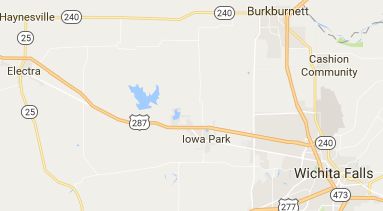 Burnett would eventually own 360,000 acres, including the land on which the town of Burkburnett (named for Burnett by Theodore Roosevelt) was founded; Waggoner would own 510,000 acres, including the land on which the town of Electra—named for Waggoner’s daughter—was founded. The Waggoner ranch was said to be the largest ranch in the United States under one fence (for perspective, Tarrant County is 570,000 acres). Both men also leased grazing land in Indian Territory (Oklahoma).
Burnett would eventually own 360,000 acres, including the land on which the town of Burkburnett (named for Burnett by Theodore Roosevelt) was founded; Waggoner would own 510,000 acres, including the land on which the town of Electra—named for Waggoner’s daughter—was founded. The Waggoner ranch was said to be the largest ranch in the United States under one fence (for perspective, Tarrant County is 570,000 acres). Both men also leased grazing land in Indian Territory (Oklahoma).
(The Waggoner Ranch, listed for sale at $725 million, was bought in 2016 by sports teams owner and billionaire Stan Kroenke, who is married to Wal-Mart heiress Ann Walton Kroenke.)
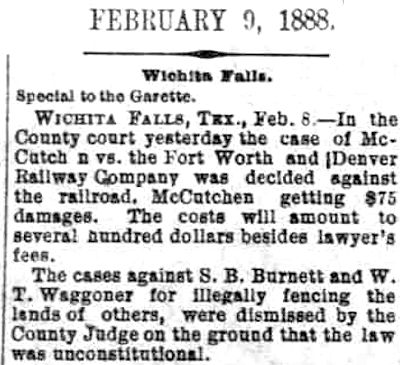 In 1888 the two men even went to court together.
In 1888 the two men even went to court together.
Both men added to their cattle and land wealth with oil. In 1911 Waggoner was drilling for water—a valuable resource in parched Texas—on his ranch. Instead he struck oil. Darn the luck! He considered the well to be polluted with the smelly, slimy stuff. He drilled another well. More oil. He drilled a third well. More oil.
Waggoner seemed to have the golden touch.
But at first he didn’t see it that way.
“Oil, oil, what do I want with damn oil?” he is said to have complained. “I’m looking for water for my cattle. That’s what my cattle need!”
Determined to find a use for the foul pollutant that his wells could not seem to avoid striking, at first Waggoner used the oil as tick dip for his cattle. But that tick dip would earn him “the greatest fortune ever amassed by one man west of the Mississippi River,” the Star-Telegram said.
But although eventually his land would bristle with oil derricks, W. T. Waggoner remained, at heart, a cowman, not an oilman.
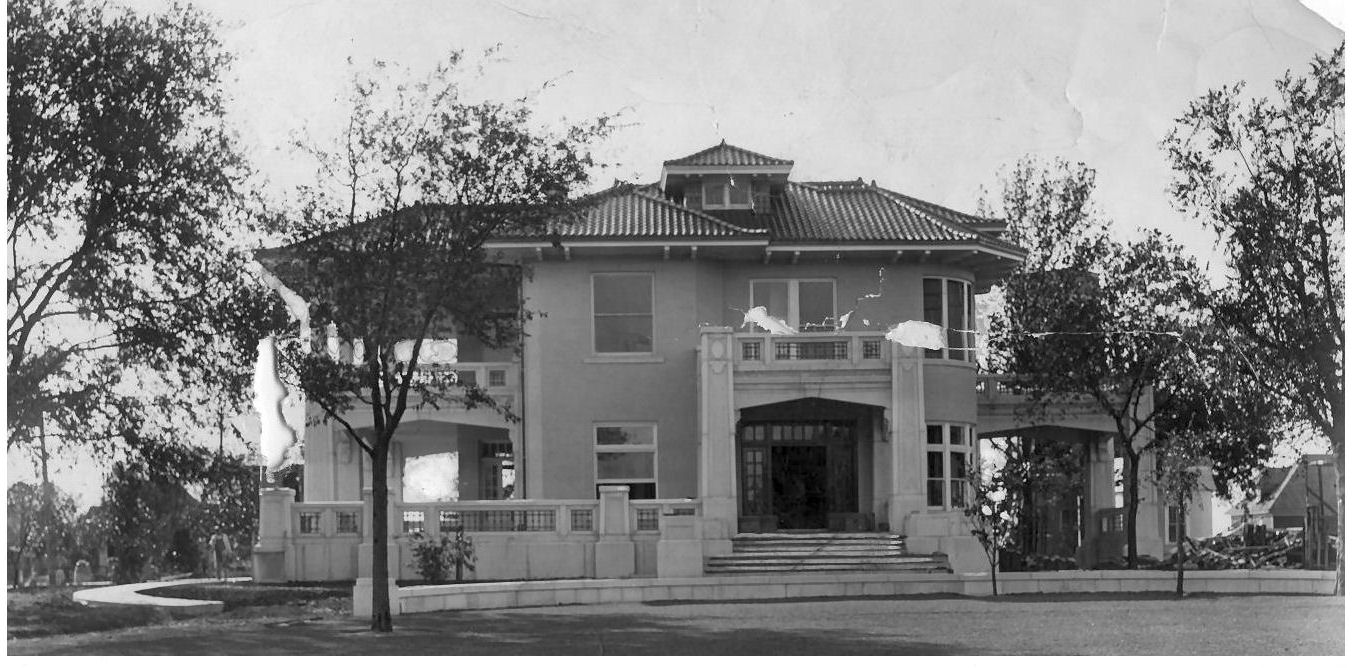
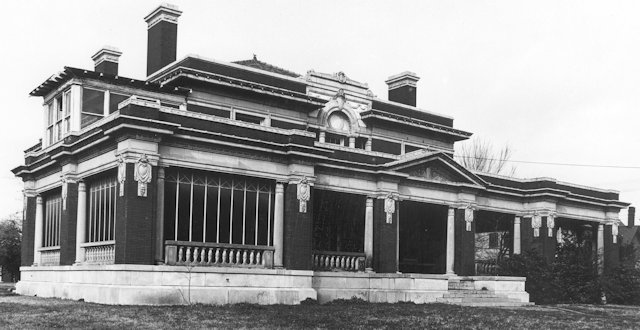
Both men moved to Fort Worth early in the twentieth century: Burnett in 1900, Waggoner in 1904. Each built a grand home on Summit Avenue on Quality Hill, Burnett at 1424, Waggoner at 1200. Burnett’s home is in the top photo (photos from UTA Library).
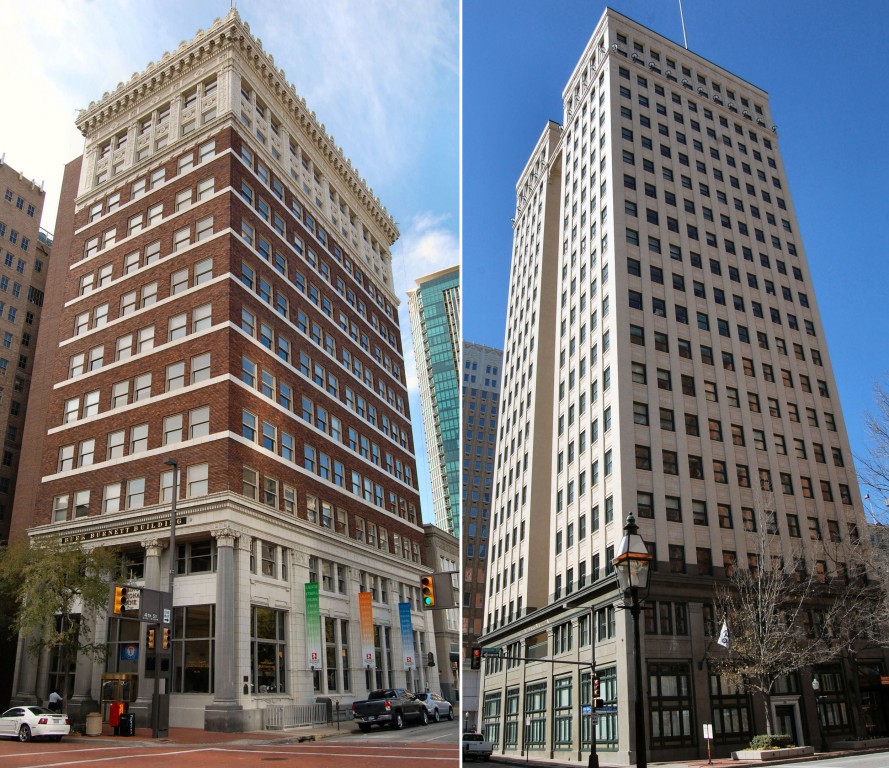
Each man owned an early skyscraper: When Burnett bought the State National Bank Building (left) in 1915, it was the tallest building in town at twelve stories. In 1920 Waggoner built his twenty-story building, then one of the tallest in the state.
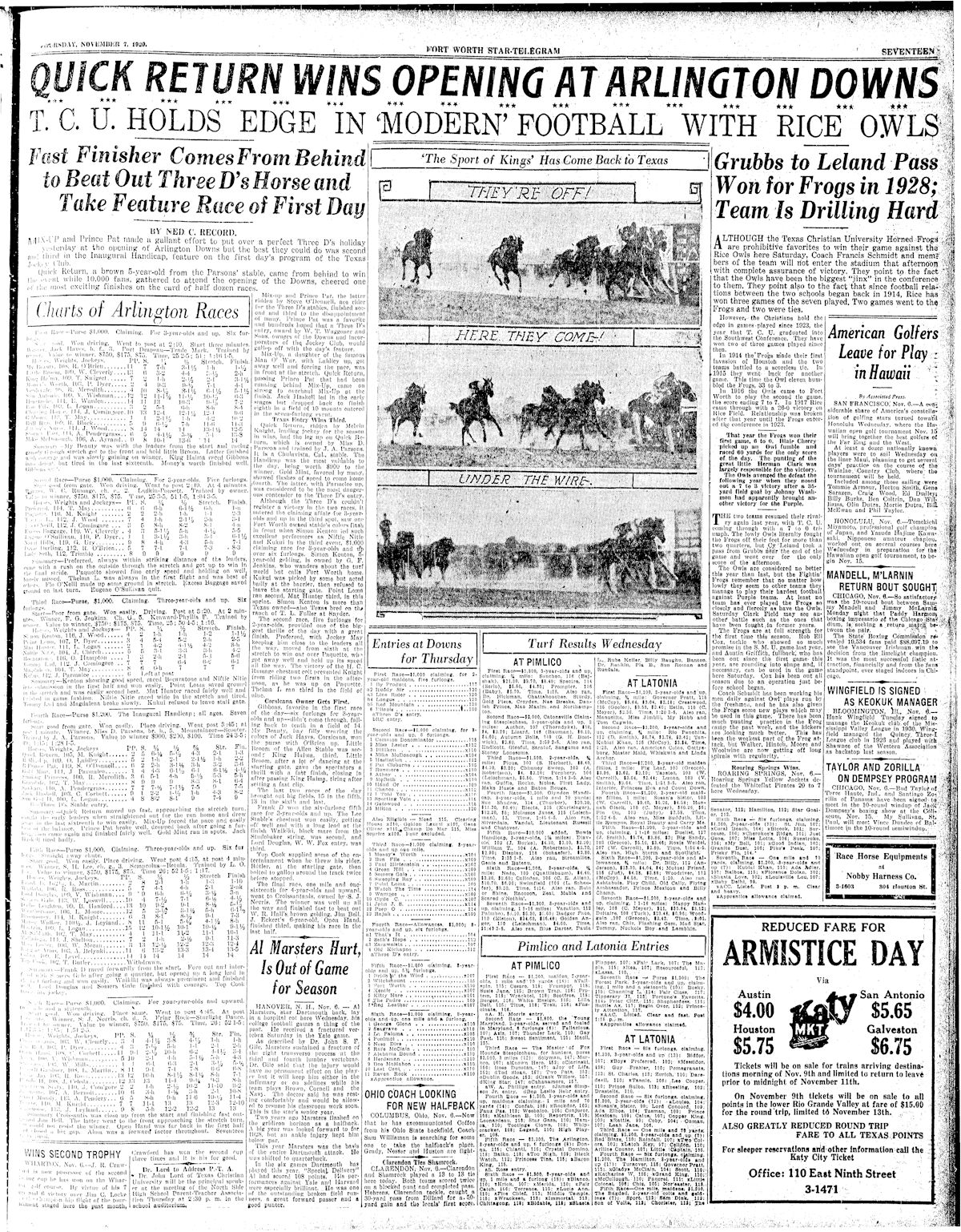
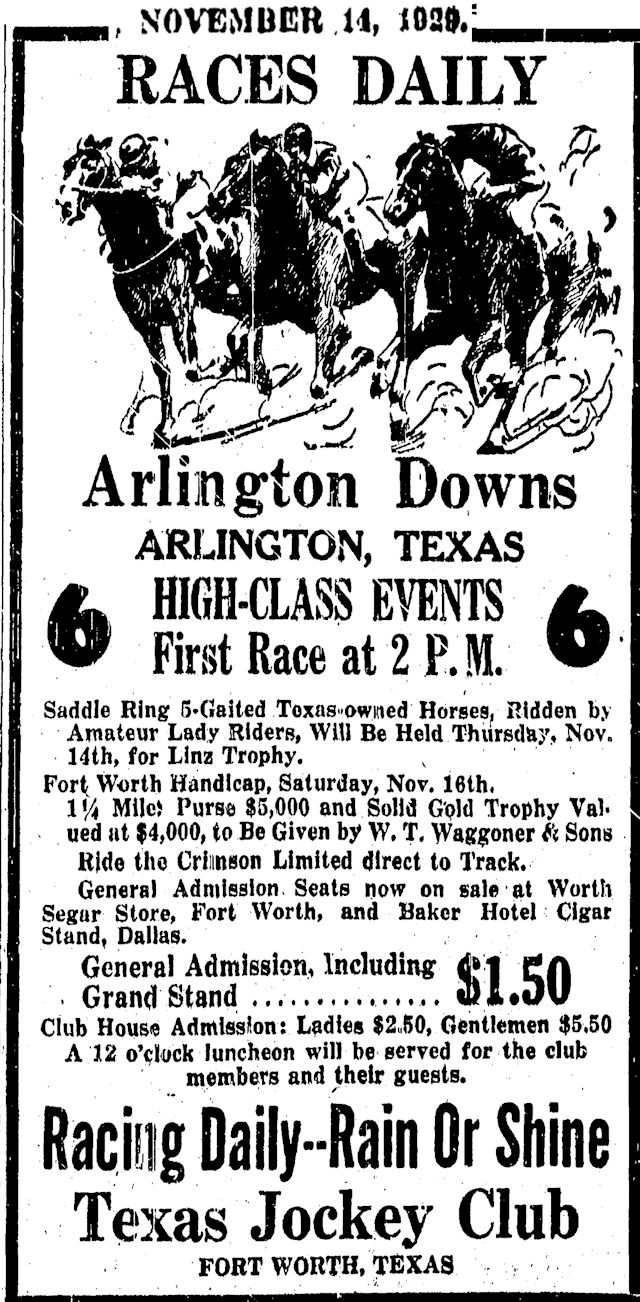
Waggoner’s other passion besides cattle was race horses. In 1929 he built Arlington Downs race track on his DDD stock farm in Arlington even though betting on horse racing was illegal in Texas at the time. But Waggoner lobbied the state legislature. In 1933 parimutuel betting became legal—one year before Waggoner died. But in 1937 the state legislature outlawed parimutuel betting, and the track soon closed. In 1942 Arlington Downs became the site of the motor pool of the Army’s Eighth Corps Area.
Great Southwest Corporation bought the property in 1956 from Waggoner son E. Paul.
 Demolition of Arlington Downs began in 1957.
Demolition of Arlington Downs began in 1957.
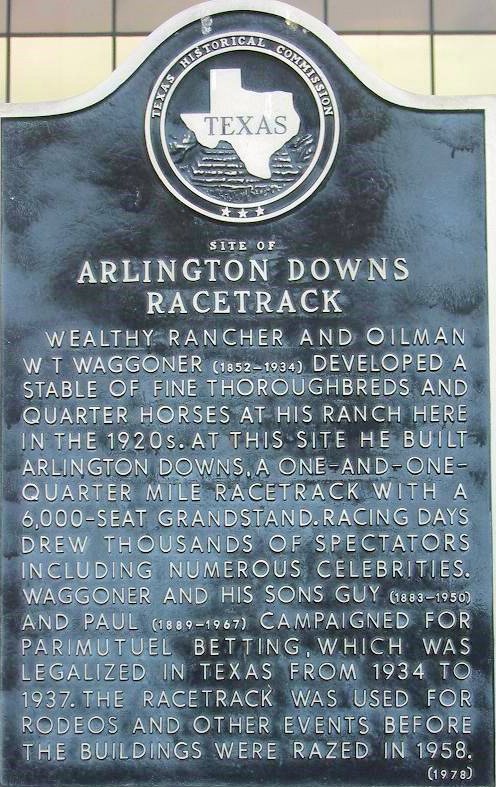 This marker is on East Randol Mill Road east of Highway 360.
This marker is on East Randol Mill Road east of Highway 360.
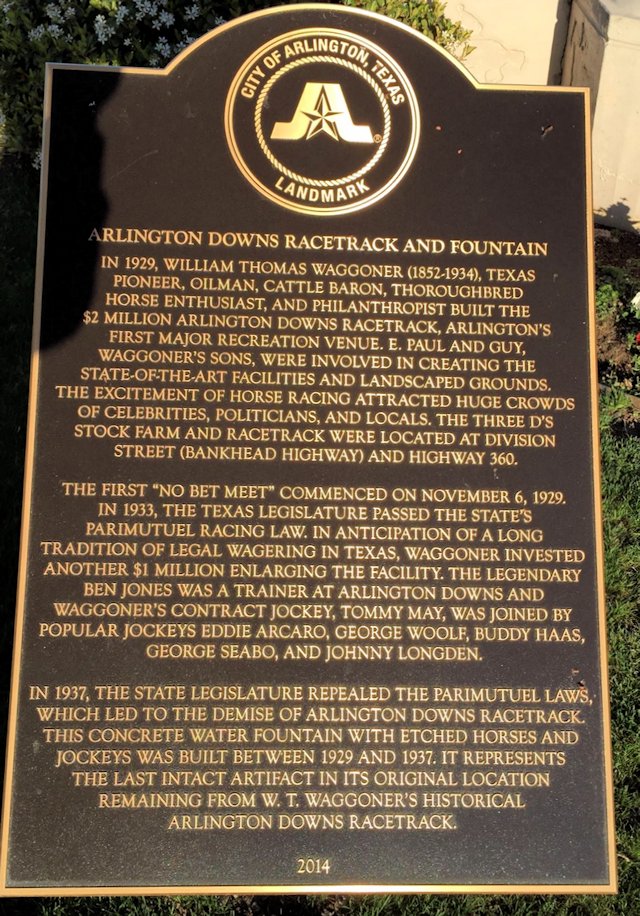
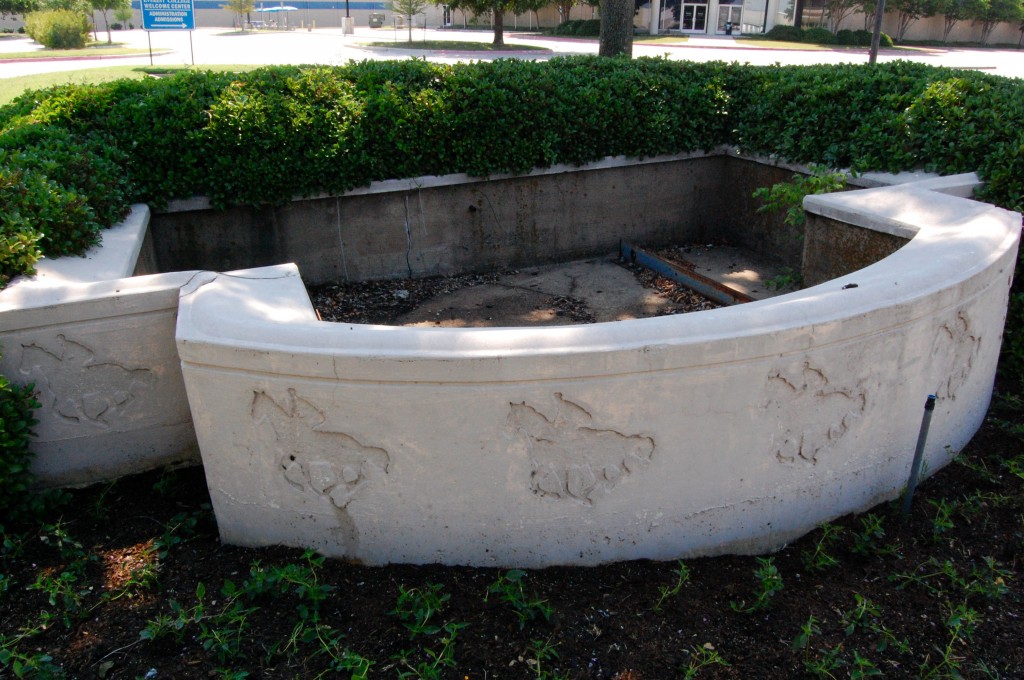
All that is left of the track now is this concrete fountain engraved with jockeys on horses at the corner of Commerce Drive and Six Flags Drive.
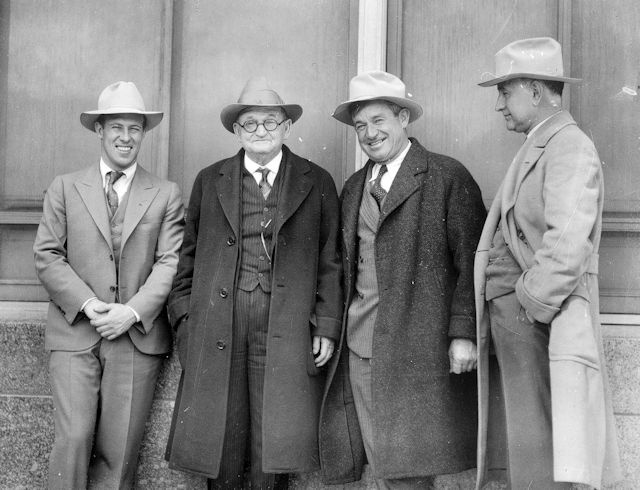
From left, Frank Hawks, W. T. Waggoner, Will Rogers, and Amon Carter, early 1930s, at Arlington Downs. Frank Hawks was a record-setting aviator known as the “fastest airman in the world.” (Photo from University of Texas at Arlington Libraries.)
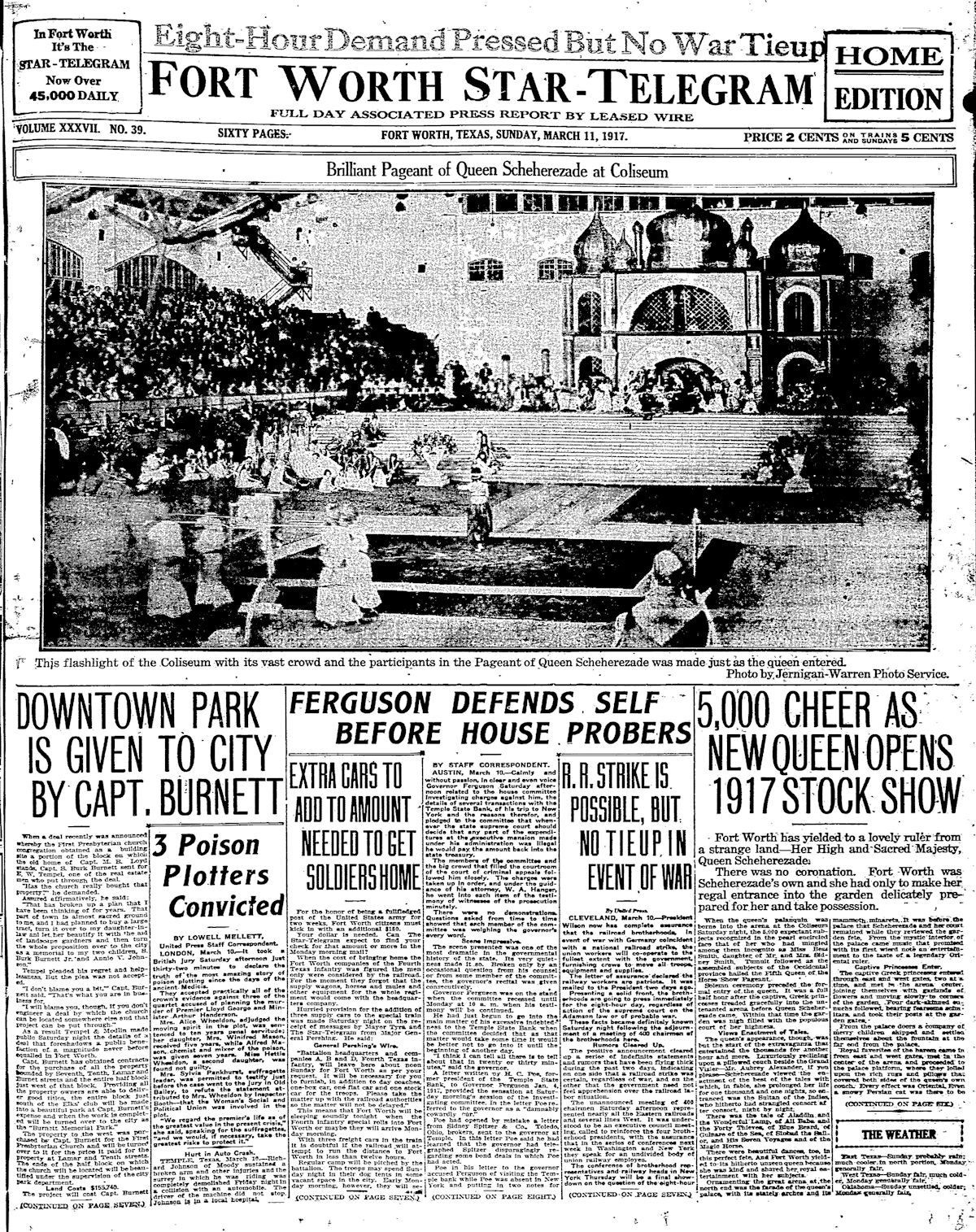 Burk Burnett built a different kind of park: In 1917 he donated land for downtown’s Burnett Park.
Burk Burnett built a different kind of park: In 1917 he donated land for downtown’s Burnett Park.
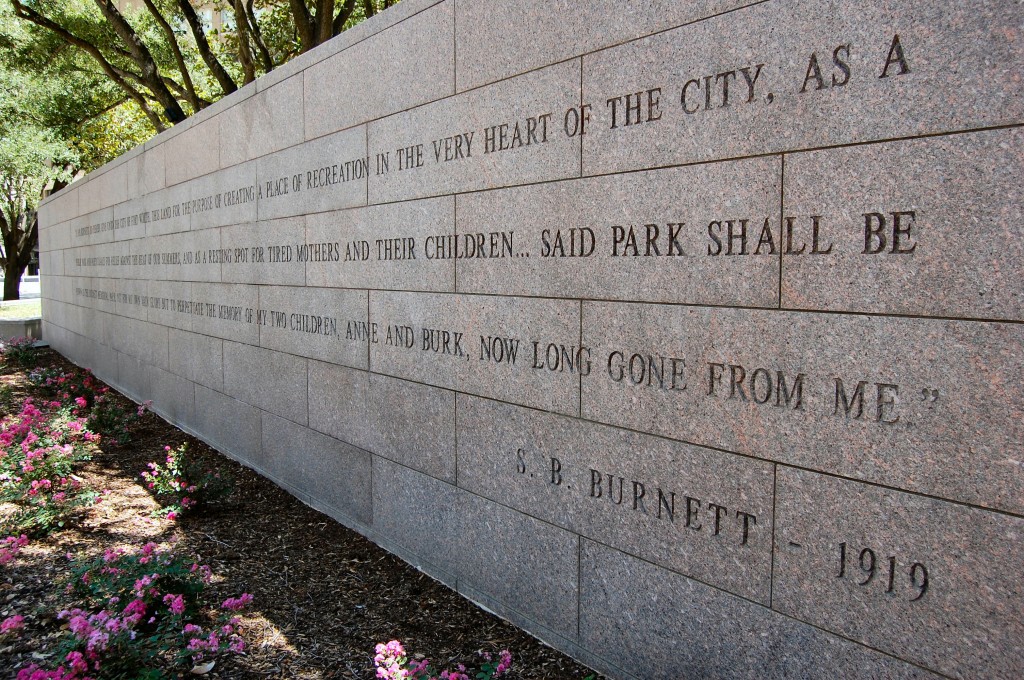
Burnett dedicated the park to his children Anne and Burk. The wall reads: “I, S. B. Burnett, do hereby give unto the city of Fort Worth this land for the purpose of creating a place of recreation in the very heart of the city, as a public park particularly for relief against the heat of our summers and as a resting spot for tired mothers and their children. The park shall be known as the Burnett Memorial Park, not for my own vain glory but to perpetuate the memory of my two children, Anne and Burk, now long gone from me. S.B. Burnett, 1919”
After President Teddy Roosevelt visited Fort Worth in 1905, Burnett and Waggoner hosted Roosevelt at a wolf hunt in Oklahoma.
Burnett and Comanche chief Quanah Parker were friends. The Comanches called Burnett “Mas-Sa-Suta” (Big Boss).
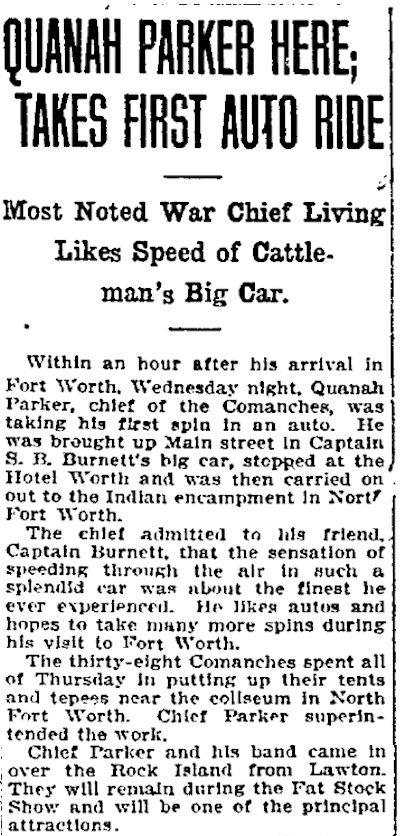 Burnett in 1909 gave Parker his first ride in an automobile. Clip is from the March 11 Star-Telegram.
Burnett in 1909 gave Parker his first ride in an automobile. Clip is from the March 11 Star-Telegram.
When Parker died in 1911, he left Burnett his finest totem pole.
Will Rogers was a friend and frequent guest of Waggoner in the 1920s. Rogers joked that each cow on Waggoner’s ranch had forty acres of grass and its own oil well.
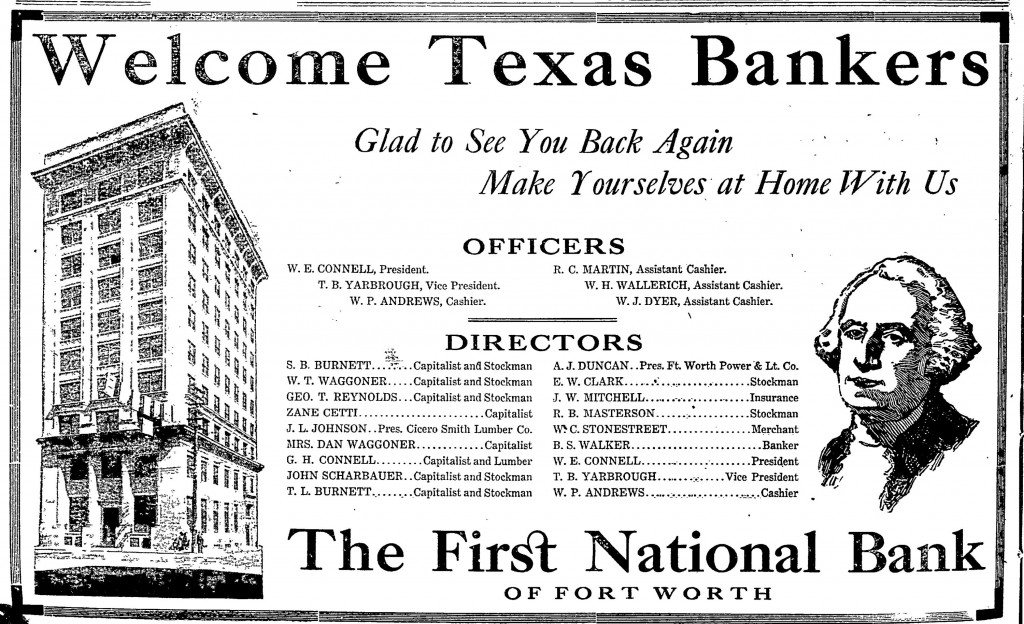
The two men were directors of First National Bank.
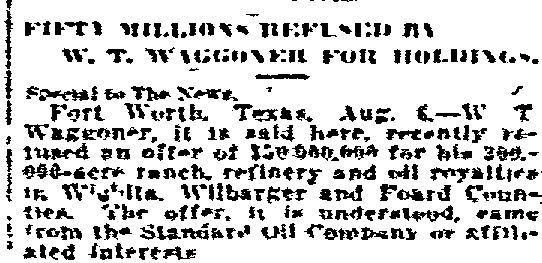
Cattle, land, oil, and banking made Burnett and Waggoner rich—rich even by Texas standards. (In the 1919 clip, Standard Oil offered Waggoner $50 million—$600 million in today’s money—for his spread. He declined.)
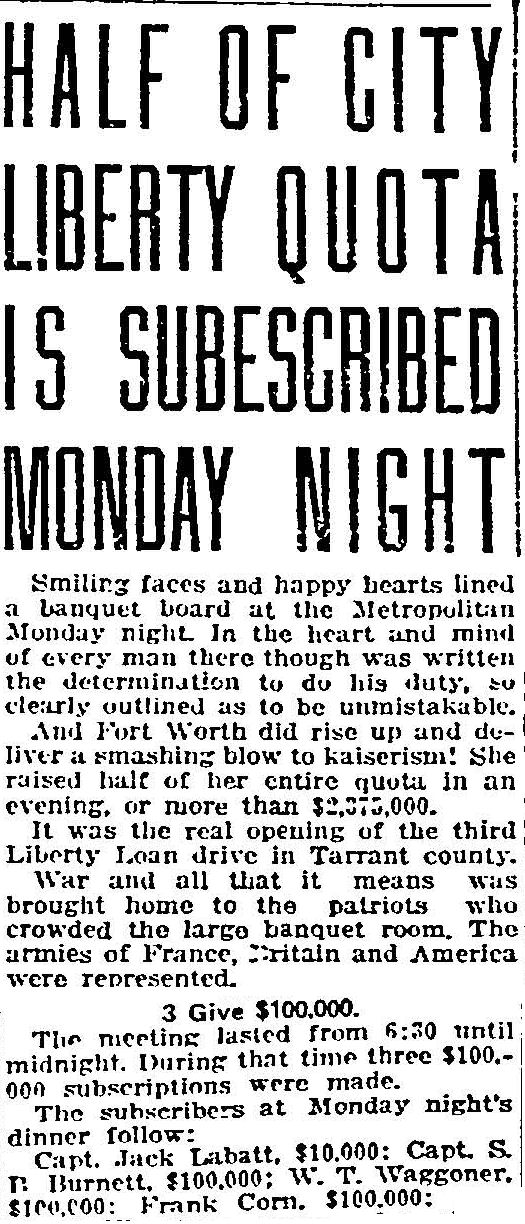
Each man gave some of his wealth back to the community. For example, each gave $100,000 to the war effort in 1918, each supported a local college: TCU for Burnett, Texas Woman’s University in Denton for Waggoner.
On, and the two men had one other tie: Waggoner’s son Guy married Burnett’s granddaughter Anne.
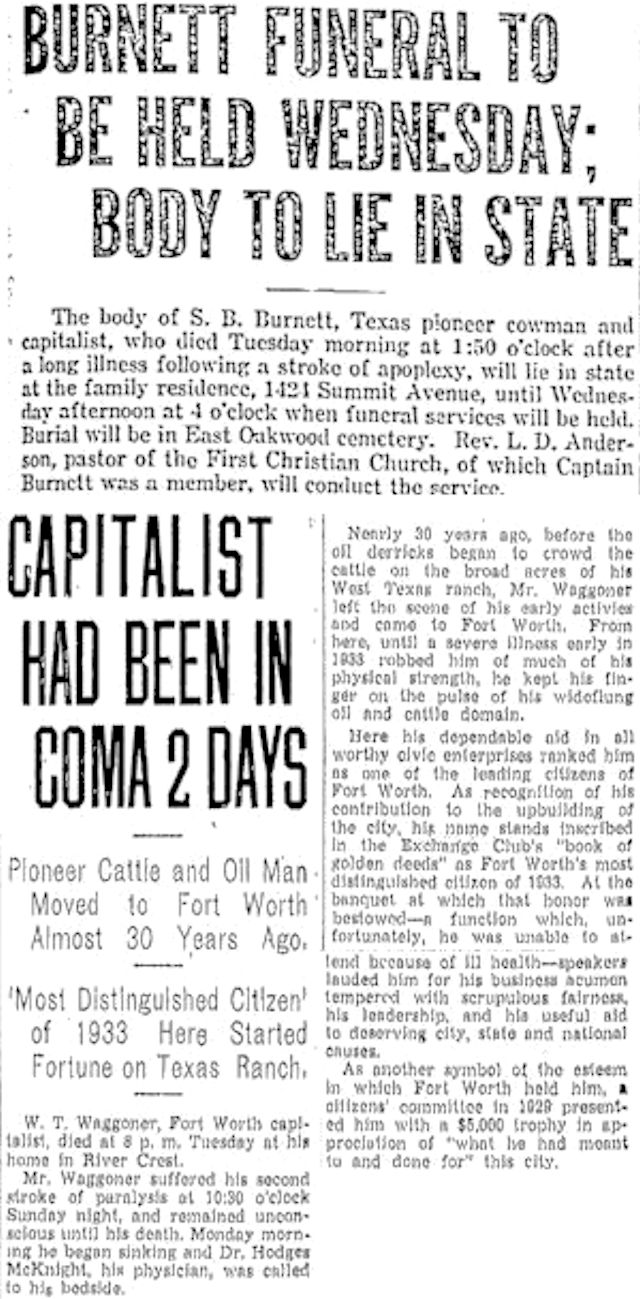
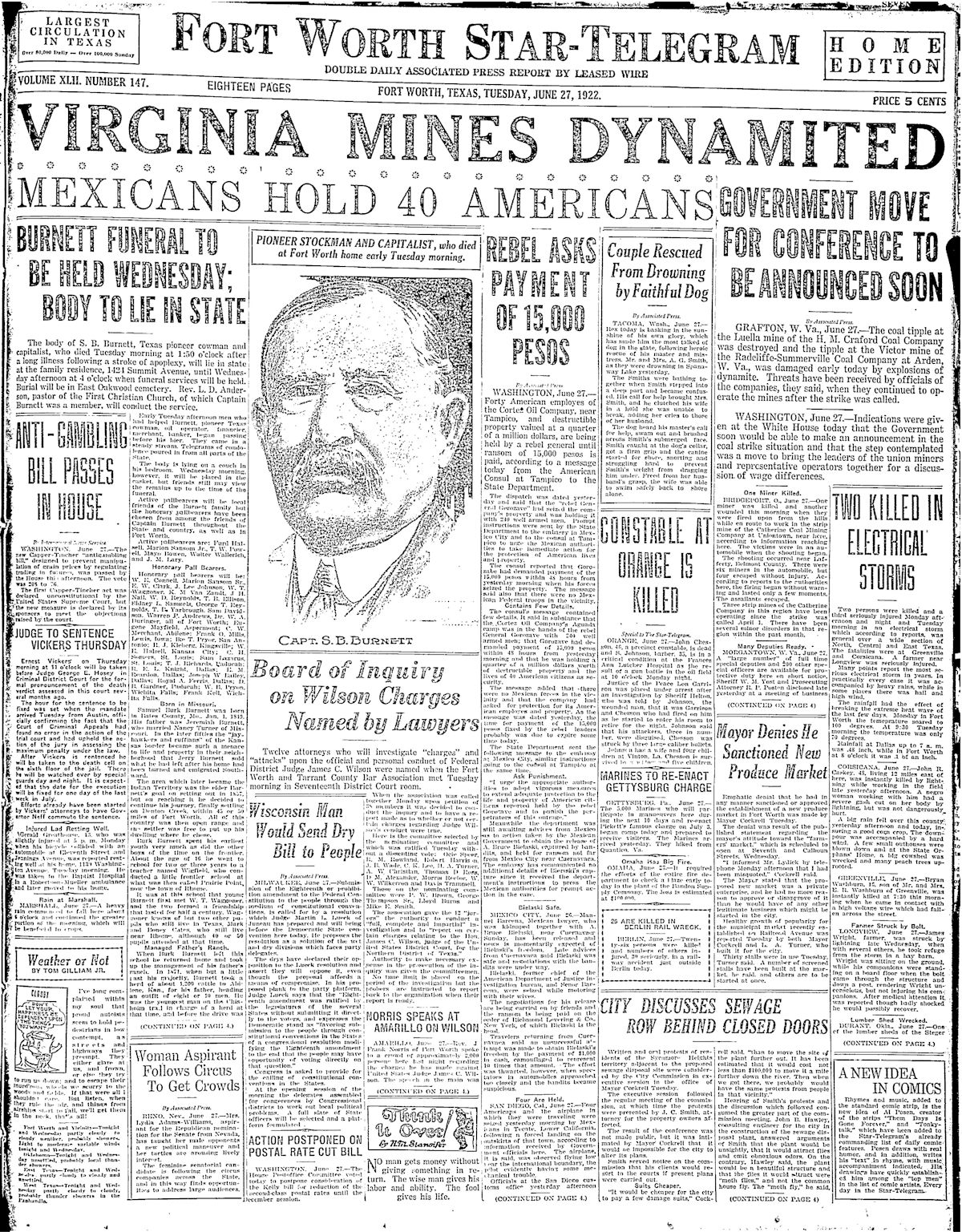
 But eventually, of course, the last roundup came for each old cowboy—on June 27, 1922 for Burnett (Waggoner was an honorary pallbearer), on December 11, 1934 for Waggoner.
But eventually, of course, the last roundup came for each old cowboy—on June 27, 1922 for Burnett (Waggoner was an honorary pallbearer), on December 11, 1934 for Waggoner.

When Burnett died he was worth $6 million ($82 million today). When Waggoner died he was worth $100 million ($1.7 billion today). Each man was buried in a mausoleum in Oakwood Cemetery. Only a few yards separate the two mausoleums. The two friends who began as neighbors on the Wise County prairie were neighbors once again.






How about the Maxwell murder case? And the fellow found with a gun stoey. Looks like 2 more good stories. I still want the Wagnor ranch; I’m only a few hundred million short. Will the owner finance? I can put a dollar down.
I once owned just sixty acres and felt like Ben Cartwright.
Please identify, more specifically, the exact location of the Arlington Downs horse watering trough. There is ‘Six Flags Drive’ and there is ‘Road to Six Flags’, but I’m not aware of a street in Arlington named ‘Six Flags Road’. Also, I have all along been under the impression that Arlington Downs was off of W. Division St., generally near the present day Candlelite Inn restaurant.
Love your fact filled and pictured and colorfully worded reporting!
Thanks.
Thanks, Mr. Cushman. The trough is at the corner of Commerce Drive and Six Flags Drive.
Outstanding. I wonder what the property tax would be on all that land. The rich guy should make it a nonprofit, put me in charge. I feel confident if I were in charge I could guarantee there would be no earnings.
Well, if he had a state agricultural exemption, as many farmers and ranchers do, that would greatly reduce his taxes. But I suspect that ranchers at his level of wealth have far more powerful ways to reduce taxes. We are talking wealth beyond the ken of mortal man. According to the DMN, when the ranch sold recently, six prospective buyers paid $15 million each just to be able to submit a bid!
Loved the article and photos. It was my honor to know friends of W. T. Waggoner, Bill and Omega Bardin, when I lived in Arlington (1968-1986). Bardin Road is named for Bill’s mom, who supposedly cooked a great lunch for Hwy 157’s surveying crew. Bill became a surveyor/engineer: his first project was laying out the old Mansfield Hwy south of Kennedale and his final project was Houston International Airport. Bill also helped lay out Arlington Downs for WT Waggoner. Bill told stories about driving Mr. Waggoner to the track when it was under construction. Mr. W. was virtually blind by this time. As they drove to the track past farm fields east of downtown Arlington, Mr. W. would ask Bill if the hay was “standing or laying.” [assume this was to indicate if it had been cut and bailed]
Mr. Bardin was also the champion of south Arlington’s “Witness Tree” which was on his parents’ farm (near Hwy 157 and I-20). Bill kept that tree alive well past its natural life, spending $ for arborists and keeping it watered. He and the tree lost this battle, and Bill had a cane and other mementos carved from its wood. Bill helped me greatly with Arlington history when I was director of the Fielder Museum in the early 1980s.
Bill and Omega moved back home to Arlington from Houston when he retired. They bought “the old Moore place” on Chantilly in south Arlington and built their home next to the old cement water tower and over the root cellar from the homestead. Bill grew a champion vegetable garden (and cotton) on the lot next door. He would invite over elementary kids from the school that backed his property to see cotton growing and let them pick some. Nice, nice memories of old Arlington friends, Bill and Omega Bardin.
Ann Bastable: Thank you. And thank you for sharing your memories of Arlington. Before we had J. R. and Southfork, we had W. T. and the DDD Ranch and S. B. and the 6666 Ranch. Men like Waggoner and Burnett built the legend of Texas.
I have been catching up on my reading after being on vacation. Interesting article. Thought I’d mention that W. T. Waggoner had my grandfather design his racetrack, which was just one of many projects not in Fort Worth. Also, looking at the First National ad, several of the men listed as officers and directors were clients of my grandfather.
Loved seeing that. I grew up in Iowa Park across the street from a house that Will & Maggie Burnett lived it. I looked just like the house in Ft. Worth (in the middle of a city block) I have lots of memories of that house & the Burnetts.
Thanks, Carol. Cliches about Texas sprang from cowmen capitalists like Burnett and Waggoner.
Fascinating. Thanks, Mike.
Thanks, Susan. Because so many people (like Burnett and Waggoner) who were born about the time of the Civil War and experienced what we now call the “wild West” lived into the 1930s, people who were young during the 1930s-such as my parents-were the bridge between my generation and a generation who had seen the world go from horse and buggy to automobiles and airplanes, from telegraph to telephone and radio, from hand fans to central air conditioning. It was a fascinating time to live through.
Thanks, Bruce. It’s fun to learn and fun to share what I learn.
I must tell you again how much I daily enjoy reading this Blog. Besides the entertainment, you’ve given me many additional ideas for photographic ventures around our city.